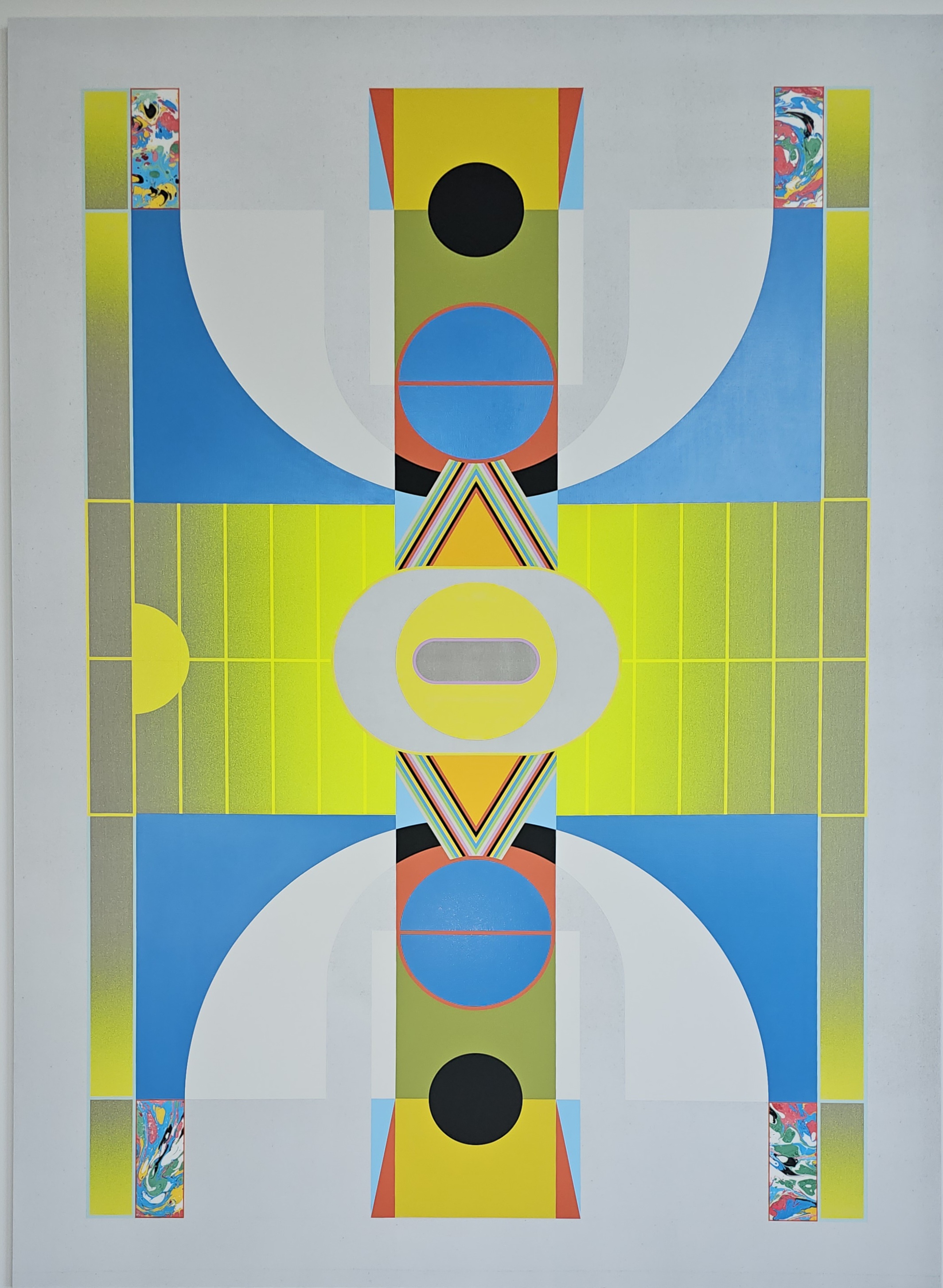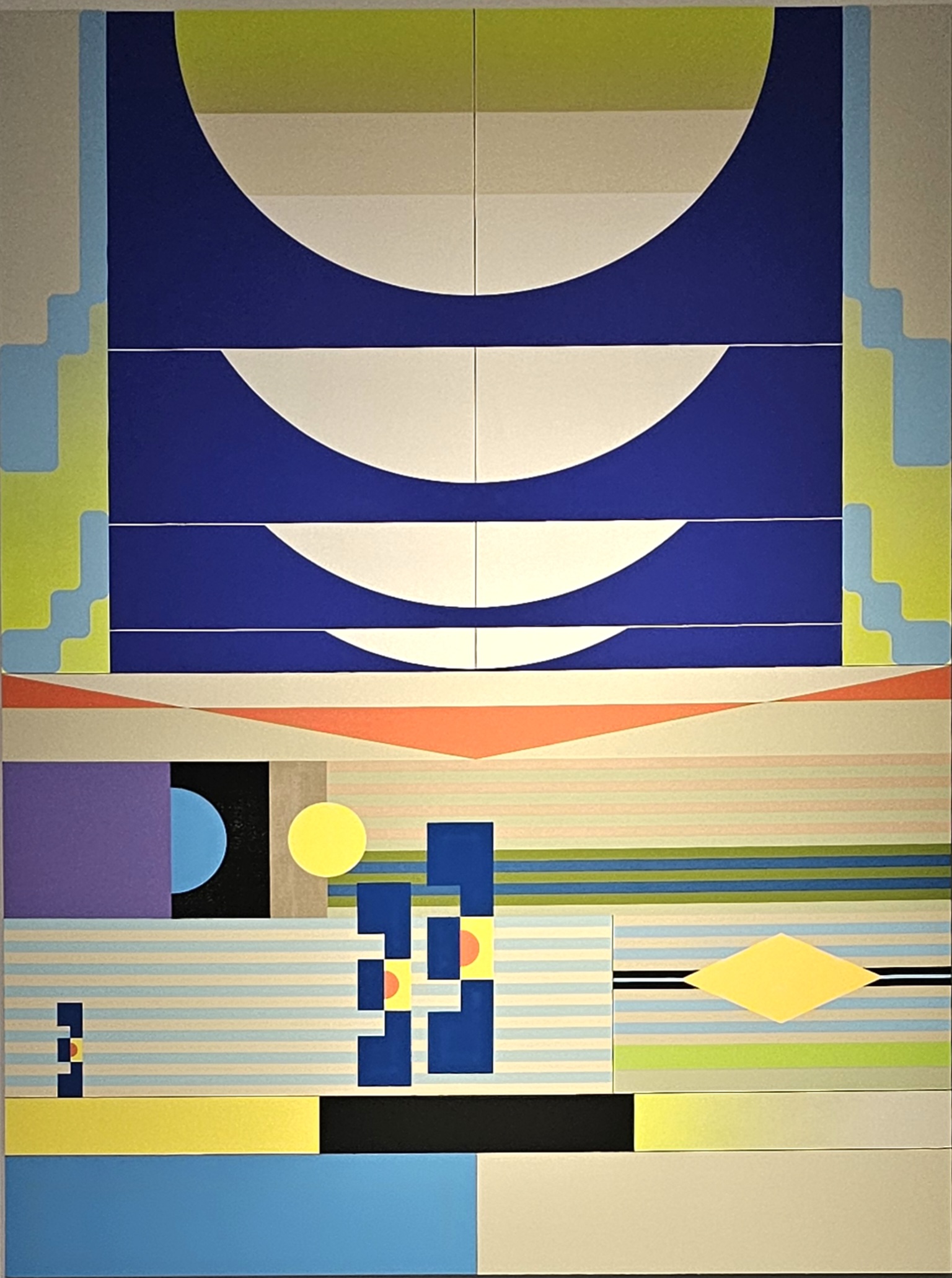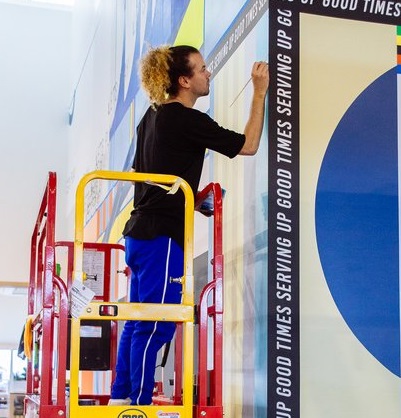Jeffrey Swider Peltz
Courtside

Courtside is designed using the combinations of geometric surfaces of various athletic courts. As a result of his many years as a competitive athlete, Swider Peltz has long been curious about the common boundaries that visually form as athletic teams or people compete against each other.
“I’ve played a lot of sports in the past and played on a lot of different surfaces. But there is a commonality with most sports. The areas where the athletes compete have lines that tell you where to go and have shapes that mean specific things. I wanted to explore that commonality of the playing surfaces that give sport a shared language.
Swider Peltz combined the shapes of the courts used for basketball, hockey, roller derby and volleyball to create a colorful composition of the defined athletic surface. With a nod to Milwaukee’s sports history, he incorporates elements of the legendary pop art Mecca floor designed by artist Robert Indiana that served as the game floor of the Milwaukee Bucks from 1974-95.
The variety of the surfaces within Courtside point to the variety of surfaces athletes play on, while the colors reflect the vibrant culture of athletic fashion and athletic arenas around the globe.
“It was important to me that the piece brightened up the space inside Baird Center. There is a lot of color and vibrant shapes which I think makes it fun. Because that ultimately is the essence of sports, we play them because they are fun and I wanted everyone who visits Baird Center to share in that fun.”
Courtside Remix

Courtside Remix takes the defined lines and geometric shapes found with athletic playing surfaces and blows them up.
“In Courtside I place the courts in their defined positions and overlaid shapes that I find interesting about the specific sports. With Courtside Remix I use the same shapes and lines found in Courtside but remove them from their defined positions. Courtside Remix is not an overlay, instead it takes the shapes, colors and lines and uses them in a fragmented manner, freeing them of their confinement. By removing the rules of an athletic playing surface, it almost gives the individual elements more importance.”
The observer will still find the bright colors and shapes of international sports within Courtside Remix. Swider Peltz incorporates the colors of international flags and athletic arenas that he enjoyed during his athletic career.
“This is really the rich mix of color that you experience when you go to each rink or competitive space across the world. You see the flags lined up in a row, showing a type of unity of people. The entire rainbow of colors is represented but within the rainbow are specific colors that represent different countries.”

About Jeffrey Swider Peltz
Born and raised in the western suburbs of Chicago, Jeffrey Swider Peltz grew up ice speedskating with his sister, often traveling several times a week after school to train at the Pettit National Ice Center. After moving to Milwaukee in 2012 and competing internationally for the US, he left speedskating to teach and make visual art.
Currently based in Chicago, Swider Peltz moves between the mediums of drawing, muraling, installation and performance. He’s interested in making human connections, public art and revisiting his athletic background. His explorations of time, repetition and space often originate from physical movement and the limitations of the body. His most recent work explores compositions constructed from the colors and geometry of various athletic courts and arenas.
Swider Peltz states that he often draws his inspiration from his time as competing for the US national team.
“Whether directly or often times quite loosely, I draw a lot from my experience as an athlete because that is a big part of who I am. When you make art that comes from your experiences and how you connect and relate to the world, I think it brings a type of authenticity to your work. What I really love about art though, is that people bring their own experiences to art and then mesh it with the artist’s ideas to create a different kind of experience.”
Swider Peltz other artistic outlet is his ūesay line of clothing. Drawing again from his years as a speedskater, he has designed the line with an eye towards the bright and vibrant colors of the skin suits worn by the athletes representing their countries in international competitions.
“I was taking a screen printing class at my alma mater because I was interested in the process and I thought I could have some fun with it. So, I began making these clothes with a lot of color and I sold them to different people when I traveled. It was pretty cool because one time I got about half of the U.S. national speedskating team wearing my cloths as an alternative to the team issued gear. It was a little fashion takeover by the skaters.”
Swider Peltz has had works commissioned works for the Wheaton College Conservatory, the Logan Square neighborhood in Chicago, the United Mural Commission in Monterrey, Mexico and for the Municipality of Beit Sahour in Beit Sahour, Palestine. His group and solo exhibitions include the Cleve Carney Museum of Art, ArtPie Gallery and Wheaton College.
He has a BA in Studio Art from Wheaton College and has worked there as an adjunct professor and teaching artist since 2023.
Q&A with Jeffrey Swider Peltz
